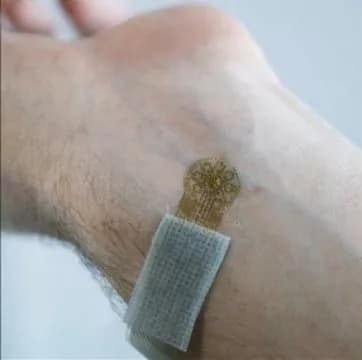
Blood-Flow Sensor For Vascular Disease Monitoring Developed, Tested
Frequent measurement of blood flow changes could improve the ability of health care providers to diagnose and treat patients with vascular conditions, such as those associated with diabetes and high blood pressure. A U.S.-Chinese team that included researchers from the National Institute of Biomedical Imaging and Bioengineering (NIBIB) and the National Heart, Lung, and Blood Institute, both parts of the National Institutes of Health, conducted a pilot study showing that an ultrathin, skin-conforming sensor -- resembling a peel-away tattoo -- provides non-invasive, precise, and continuous monitoring of circulation, including blood flow within the smallest vessels.
In a study published in the Oct. 30, 2015 issue of Science Advances, the researchers showed that the sensor can measure blood flow in both large and micro-sized blood vessels near the skin's surface. They also provided details about the design and operation of the device. The researchers assessed the sensor's performance under various conditions, showing that the technology could be used for continuous blood-flow monitoring during daily activities and in a variety of clinical research and health care settings.
In addition to diabetes and chronic hypertension, conditions that affect the health of blood vessels and surrounding tissue include kidney disease, autoimmune and other inflammatory conditions, the effects of aging and smoking, and a class of cholesterol-related abnormalities called dyslipidemias. Continuous monitoring of variations in blood flow could also be valuable in assessing these conditions in clinical and research scenarios.
The pilot-tested device, co-developed with researchers at Northwestern University, is among a variety of tools available to measure blood flow.. Other devices, such as ones based on optical or acoustic methods, however, do not work as well when the body is in motion, and thus require a patient or study subject to remain still.
The researchers overcame these challenges with the soft, skin-conforming electronic device that is applied directly onto the skin and uses thermal sensors to collect data on changes in temperature, including those caused by changes in blood flow. The device can also apply a small amount of heat in order to test a subject's responses. In this mode, a miniature pad in the device generates a heat impulse, while 14 surrounding thermal sensors detect the resulting heat flux. The signal is sent to a computer that calculates the velocity of blood flow occurring within two millimeters of the skin surface.
In their study, the researchers placed the sensor on a study subject's forearm, over a large, visible vein, and then applied pressure for 60 seconds at various positions near the vein. Each time, the device sensed corresponding reductions in blood flow. The researchers also used a thermal camera that measures infrared signals to confirm that the blood-flow sensor measurements were accurate, even when the subject moved around.
Next, they chose a placement on the forearm that was not near a large vein, so that the device would detect blood flow in micro-sized blood vessels within the underlying tissue. The researchers were able to detect changes in blood flow when the study subject took a deep breath. Members of the team at a collaborating institution performed a separate test that involved delivering a gentle slap to the skin near the electronic sensor, which caused a mild reddening reaction. The sensor registered the skin reaction as an increase of surface temperature, accompanied by a change in the direction of blood flow within two millimeters of the skin's surface.
According to co-author Alexander Gorbach, Ph.D., head of NIBIB's Infrared Imaging and Thermometry Unit, the tests performed with the thermal sensor helped to establish a number of guidelines for its use, such as optimal placement of the sensor, and how deeply under the skin's surface the device can assess blood flow. At this stage, the device shows promise as a low-cost, readily-fabricated sensor for use in ambulatory or hospital-based settings. Because of the link between chronic hypertension and some types of vascular diseases, the new sensor may be a useful addition to studies of hypertension and its consequences.
Dr. Gorbach had taken part in prior research, published in 2013, that tested the electronic sensor's use for collecting continuous body temperature readings. In that study, the team tested the device for use in monitoring the skin temperature of patients under observation for infection or other illnesses. "The clinical standard for temperature readings is two times per day, but this device can send readings two times per second," he said. In addition, the device can also be used during surgery to monitor the temperature and blood flow of internal organs.
The above post is reprinted from materials provided by National Institute of Biomedical Imaging and Bioengineering. Note: Materials may be edited for content and length.
Disclaimer: DoveMed is not responsible for the adapted accuracy of news releases posted to DoveMed by contributing universities and institutions.
Primary Resource:
Webb, R. C., Ma, Y., Krishnan, S., Li, Y., Yoon, S., Guo, X., ... & Kurniawan, J. (2015). Epidermal devices for noninvasive, precise, and continuous mapping of macrovascular and microvascular blood flow.Science advances, 1(9), e1500701.
Related Articles
Test Your Knowledge
Asked by users
Related Centers
Related Specialties
Related Physicians
Related Procedures
Related Resources
Join DoveHubs
and connect with fellow professionals

0 Comments
Please log in to post a comment.